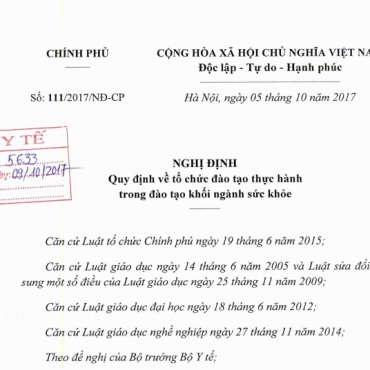Liên hệ tuyển sinh
Hợp tác Quốc tế
Molecular Diagnostic Yield of Exome Sequencing in Patients With Cerebral Palsy
Molecular Diagnostic Yield of Exome Sequencing in Patients With Cerebral Palsy
Andrés Moreno-De-Luca, MD1,2,3,4; Francisca Millan, MD5; Denis R. Pesacreta, BS1; et alHouda Z. Elloumi, PhD5; Matthew T. Oetjens, PhD1; Claire Teigen, MS5; Karen E. Wain, MS1,2; Julie Scuffins, MS5; Scott M. Myers, MD1; Rebecca I. Torene, PhD5; Vladimir G. Gainullin, PhD5; Kevin Arvai, MS5; H. Lester Kirchner, PhD6; David H. Ledbetter, PhD1,2; Kyle Retterer, MS5; Christa L. Martin, PhD1,2
JAMA. 2021;325(5):467-475. doi:10.1001/jama.2020.26148
Question What is the molecular diagnostic yield of exome sequencing (prevalence of pathogenic and likely pathogenic variants) among patients with cerebral palsy?
Findings In this cross-sectional study that included 2 independent cohorts of 1526 patients with cerebral palsy, the molecular diagnostic yield of exome sequencing was 32.7% in a cohort that predominantly consisted of pediatric patients and 10.5% in a cohort that predominantly consisted of adult patients.
Meaning This study identified pathogenic and likely pathogenic variants among some patients with cerebral palsy, although further research is needed to understand the clinical implications of these findings.
Abstract
Importance Cerebral palsy is a common neurodevelopmental disorder affecting movement and posture that often co-occurs with other neurodevelopmental disorders. Individual cases of cerebral palsy are often attributed to birth asphyxia; however, recent studies indicate that asphyxia accounts for less than 10% of cerebral palsy cases.
Objective To determine the molecular diagnostic yield of exome sequencing (prevalence of pathogenic and likely pathogenic variants) in individuals with cerebral palsy.
Design, Setting, and Participants A retrospective cohort study of patients with cerebral palsy that included a clinical laboratory referral cohort with data accrued between 2012 and 2018 and a health care–based cohort with data accrued between 2007 and 2017.
Exposures Exome sequencing with copy number variant detection.
Main Outcomes and Measures The primary outcome was the molecular diagnostic yield of exome sequencing.
Results Among 1345 patients from the clinical laboratory referral cohort, the median age was 8.8 years (interquartile range, 4.4-14.7 years; range, 0.1-66 years) and 601 (45%) were female. Among 181 patients in the health care–based cohort, the median age was 41.9 years (interquartile range, 28.0-59.6 years; range, 4.8-89 years) and 96 (53%) were female. The molecular diagnostic yield of exome sequencing was 32.7% (95% CI, 30.2%-35.2%) in the clinical laboratory referral cohort and 10.5% (95% CI, 6.0%-15.0%) in the health care–based cohort. The molecular diagnostic yield ranged from 11.2% (95% CI, 6.4%-16.2%) for patients without intellectual disability, epilepsy, or autism spectrum disorder to 32.9% (95% CI, 25.7%-40.1%) for patients with all 3 comorbidities. Pathogenic and likely pathogenic variants were identified in 229 genes (29.5% of 1526 patients); 86 genes were mutated in 2 or more patients (20.1% of 1526 patients) and 10 genes with mutations were independently identified in both cohorts (2.9% of 1526 patients).
Conclusions and Relevance Among 2 cohorts of patients with cerebral palsy who underwent exome sequencing, the prevalence of pathogenic and likely pathogenic variants was 32.7% in a cohort that predominantly consisted of pediatric patients and 10.5% in a cohort that predominantly consisted of adult patients. Further research is needed to understand the clinical implications of these findings.
Source: http://pctu.edu.vn/vn/new-issue-mobile-stroke-units-and-stroke-outcomes-yield-of-exome-sequencing-for-cerebral-palsy-uspstf-guideline-on-screening-for-carotid-artery-stenosis-and-more.html
Các tin khác
- Đơn trị liệu bằng Ticagrelor hoặc Clopidogrel và liệu pháp kháng tiểu cầu kép sau can thiệp mạch vành qua da ( 16:16 - 29/03/2024 )
- Effect of Endovascular Treatment Alone vs Intravenous Alteplase Plus Endovascular Treatment on Functional Independence in Patients With Acute Ischemic Stroke ( 15:26 - 20/05/2021 )
- Autoimmune Testing in Primary Care for Rheumatology Referrals ( 15:42 - 19/05/2021 )
- Chronic Kidney Disease: Laboratory Support of Diagnosis and Management ( 15:38 - 19/05/2021 )
- Screening for Asymptomatic Carotid Artery Stenosis: Recommendation Statement ( 15:52 - 18/05/2021 )
- Hypothyroidism: Diagnosis and Treatment ( 15:32 - 18/05/2021 )
- Association Between Dispatch of Mobile Stroke Units and Functional Outcomes Among Patients With Acute Ischemic Stroke in Berlin ( 13:41 - 18/05/2021 )
- Screening for Hypertension in Adults US Preventive Services Task Force Reaffirmation Recommendation Statement ( 14:46 - 15/05/2021 )














